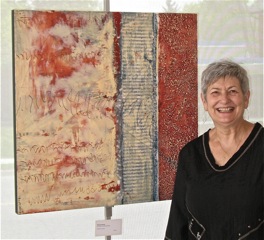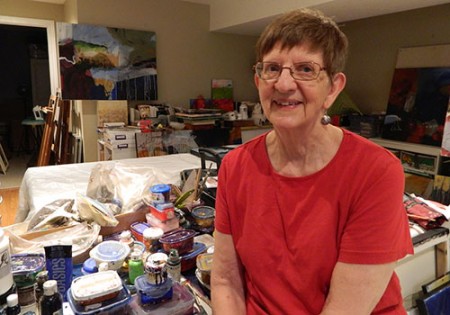The Guelph community is invited to visit 42 artists in their studios or exhibition spaces and watch them work for the annual Guelph Studio Tour Oct. 16-18. Celebrating its 30th anniversary, the tour will feature 19 University of Guelph graduates, including encaustic artist Deb Dryden and Nancy Farrell, who creates paintings with found objects.

Encaustic art involves painting with a mixture of pigment and beeswax. Once the coloured wax is applied to the prepared board, Dryden uses a blowtorch, heat gun or other heat source to fuse each layer, and scrapes and incises with one of her tools. She also inlays objects in the wax, from bits of gold foil to printed papers and leaves.
“The beauty of working with wax is it’s very translucent, so you get this wonderful texture and depth,” she says.
Dryden graduated from the University of Guelph’s Fine Arts program in 1969 with a focus on printmaking. She later became an art teacher and continued to create her own work. Several years ago she took an encaustic painting course in Toronto; Dryden says she was immediately smitten and began experimenting with the technique.
Two of her encaustic paintings of poppies are included in the John McCrae exhibit currently on display at the Guelph Civic Museum. A local company recently purchased three other pieces of her work. “There aren’t many places to show and sell art in Guelph,” says Dryden. “That’s what makes the tour so important.”
During the tour, Dryden will demonstrate her techniques and give visitors the opportunity to see her working with the hot wax.
Nancy Farrell, who graduated from the U of G in 1993, says she started by studying sculpture and painting, but soon found her niche in ceramic sculpture. Her focus changed again when she developed arthritis and could not longer manage the heavy pieces of art she was producing.

Instead, she returned to her early interest in painting. “I do non-objective painting,” she says. “That means there is no identifiable person, place or thing. My painting is all about colour, line and shape – the elements of design.”
She says these pieces are harder to create than more realistic paintings, but she enjoys the challenge. “I have a lot of movement and activity in my paintings, and people look at them and see different things.”
Much of her work incorporates found objects such as branches, plastic discards and other items.
Farrell’s paintings are currently on display in galleries in Ottawa, Milton and Toronto, and she’ll be participating in several art shows over the fall. The Guelph Studio Tour, though, is one of her favourites because “it gives me a chance to explain my work and what I do.”
For more information about the event, visit www.guelphstudiotour.ca.